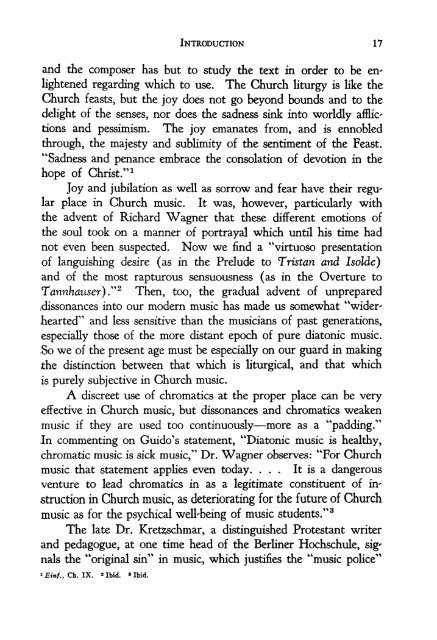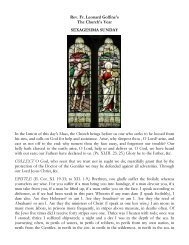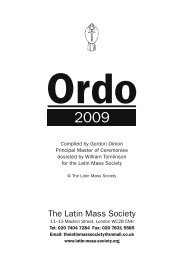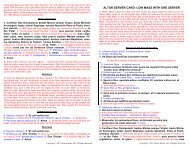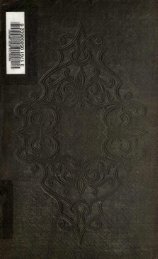The Spirit of Gregorian Chant - Church Music Association of America
The Spirit of Gregorian Chant - Church Music Association of America
The Spirit of Gregorian Chant - Church Music Association of America
You also want an ePaper? Increase the reach of your titles
YUMPU automatically turns print PDFs into web optimized ePapers that Google loves.
INTRODUCTION 17<br />
and the composer has but to study the text in order to be enlightened<br />
regarding which to use. <strong>The</strong> <strong>Church</strong> liturgy is like the<br />
<strong>Church</strong> feasts, but the joy does not go beyond bounds and to the<br />
delight <strong>of</strong> the senses, nor does the sadness sink into worldly afflictions<br />
and pessimism. <strong>The</strong> joy emanates from, and is ennobled<br />
through, the majesty and sublimity <strong>of</strong> the sentiment <strong>of</strong> the Feast.<br />
"Sadness and penance embrace the consolation <strong>of</strong> devotion in the<br />
hope <strong>of</strong> Christ. 1 ' 1<br />
Joy and jubilation as well as sorrow and fear have their regular<br />
place in <strong>Church</strong> music. It was, however, particularly with<br />
the advent <strong>of</strong> Richard Wagner that these different emotions <strong>of</strong><br />
the soul took on a manner <strong>of</strong> portrayal which until his time had<br />
not even been suspected. Now we find a "virtuoso presentation<br />
<strong>of</strong> languishing desire (as in the Prelude to Tristan and Isolde)<br />
and <strong>of</strong> the most rapturous sensuousness (as in the Overture to<br />
Tannhauser)" 2 <strong>The</strong>n, too, the gradual advent <strong>of</strong> unprepared<br />
dissonances into our modern music has made us somewhat "widerhearted"<br />
and less sensitive than the musicians <strong>of</strong> past generations,<br />
especially those <strong>of</strong> the more distant epoch <strong>of</strong> pure diatonic music.<br />
So we <strong>of</strong> the present age must be especially on our guard in making<br />
the distinction between that which is liturgical, and that which<br />
is purely subjective in <strong>Church</strong> music.<br />
A discreet use <strong>of</strong> chromatics at the proper place can be very<br />
effective in <strong>Church</strong> music, but dissonances and chromatics weaken<br />
music if they are used too continuously—more as a "padding."<br />
In commenting on Guido's statement, "Diatonic music is healthy,<br />
chromatic music is sick music," Dr. Wagner observes: "For <strong>Church</strong><br />
music that statement applies even today. ... It is a dangerous<br />
venture to lead chromatics in as a legitimate constituent <strong>of</strong> instruction<br />
in <strong>Church</strong> music, as deteriorating for the future <strong>of</strong> <strong>Church</strong><br />
music as for the psychical well-being <strong>of</strong> music students." 3<br />
<strong>The</strong> late Dr. Kretz^chmar, a distinguished Protestant writer<br />
and pedagogue, at one time head <strong>of</strong> the Berliner Hochschule, signals<br />
the "original sin" in music, which justifies the "music police"<br />
i Einf., Ch. IX. * i^d. » Ibid.


